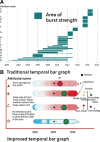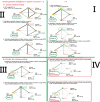Trend and prediction of citations on the topic of neuromuscular junctions in 100 top-cited articles since 2001 using a temporal bar graph: A bibliometric analysis
- PMID: 36221404
- PMCID: PMC9542577
- DOI: 10.1097/MD.0000000000030674
Trend and prediction of citations on the topic of neuromuscular junctions in 100 top-cited articles since 2001 using a temporal bar graph: A bibliometric analysis
Abstract
Background: A neuromuscular junction (NMJ) (or myoneural junction) is a chemical synapse between a motor neuron (MN) and a muscle fiber. Although numerous articles have been published, no such analyses on trend or prediction of citations in NMJ were characterized using the temporal bar graph (TBG). This study is to identify the most dominant entities in the 100 top-cited articles in NMJ (T100MNJ for short) since 2001; to verify the improved TBG that is viable for trend analysis; and to investigate whether medical subject headings (MeSH terms) can be used to predict article citations.
Methods: We downloaded T100MNJ from the PubMed database by searching the string ("NMJ" [MeSH Major Topic] AND ("2001" [Date - Modification]: "2021" [Date - Modification])) and matching citations to each article. Cluster analysis of citations was performed to select the most cited entities (e.g., authors, research institutes, affiliated countries, journals, and MeSH terms) in T100MNJ using social network analysis. The trend analysis was displayed using TBG with two major features of burst spot and trend development. Next, we examined the MeSH prediction effect on article citations using its correlation coefficients (CC) when the mean citations in MeSH terms were collected in 100 top-cited articles related to NMJ (T100NMJs).
Results: The most dominant entities (i.e., country, journal, MesH term, and article in T100NMJ) in citations were the US (with impact factor [IF] = 142.2 = 10237/72), neuron (with IF = 151.3 = 3630/24), metabolism (with IF = 133.02), and article authored by Wagh et al from Germany in 2006 (with 342 citing articles). The improved TBG was demonstrated to highlight the citation evolution using burst spots, trend development, and line-chart plots. MeSH terms were evident in the prediction power on the number of article citations (CC = 0.40, t = 4.34).
Conclusion: Two major breakthroughs were made by developing the improved TBG applied to bibliographical studies and the prediction of article citations using the impact factor of MeSH terms in T100NMJ. These visualizations of improved TBG and scatter plots in trend, and prediction analyses are recommended for future academic pursuits and applications in other disciplines.
Copyright © 2022 the Author(s). Published by Wolters Kluwer Health, Inc.
Conflict of interest statement
The authors have no funding and conflicts of interest to disclose.
Figures










Similar articles
-
Predicting article citations using data of 100 top-cited publications in the journal Medicine since 2011: A bibliometric analysis.Medicine (Baltimore). 2020 Oct 30;99(44):e22885. doi: 10.1097/MD.0000000000022885. Medicine (Baltimore). 2020. PMID: 33126338 Free PMC article.
-
Predicting article citations using data from 100 top-cited publications in the field of Psoriasis Vulgaris and biological agents (PVBA) since 1991: A bibliometric analysis.Medicine (Baltimore). 2022 Jul 29;101(30):e29396. doi: 10.1097/MD.0000000000029396. Medicine (Baltimore). 2022. PMID: 35905256 Free PMC article.
-
Citation analysis of the 100 top-cited articles on the topic of hidradenitis suppurativa since 2013 using Sankey diagrams: Bibliometric analysis.Medicine (Baltimore). 2022 Nov 4;101(44):e31144. doi: 10.1097/MD.0000000000031144. Medicine (Baltimore). 2022. PMID: 36343026 Free PMC article.
-
Using Kano diagrams to display the most cited article types, affiliated countries, authors and MeSH terms on spinal surgery in recent 12 years.Eur J Med Res. 2021 Feb 23;26(1):22. doi: 10.1186/s40001-021-00494-x. Eur J Med Res. 2021. PMID: 33622416 Free PMC article. Review.
-
A Bibliometric Analysis of the Most Cited Articles in Neurocritical Care Research.Neurocrit Care. 2019 Oct;31(2):365-372. doi: 10.1007/s12028-019-00731-6. Neurocrit Care. 2019. PMID: 31087256 Review.
Cited by
-
A modern approach with follower-leading clustering algorithm for visualizing author collaborations and article themes in skin cancer research: A bibliometric analysis.Medicine (Baltimore). 2023 Nov 3;102(44):e34801. doi: 10.1097/MD.0000000000034801. Medicine (Baltimore). 2023. PMID: 37933006 Free PMC article.
-
Trends and hotspots related to traditional and modern approaches on acupuncture for stroke: A bibliometric and visualization analysis.Medicine (Baltimore). 2023 Dec 1;102(48):e35332. doi: 10.1097/MD.0000000000035332. Medicine (Baltimore). 2023. PMID: 38050290 Free PMC article.
-
A leading bibliometric author does not have a dominant contribution to research based on the CJAL score: Bibliometric analysis.Medicine (Baltimore). 2023 Jan 13;102(2):e32609. doi: 10.1097/MD.0000000000032609. Medicine (Baltimore). 2023. PMID: 36637941 Free PMC article.
-
Using chord diagrams to explore article themes in 100 top-cited articles citing Hirsch's h-index since 2005: A bibliometric analysis.Medicine (Baltimore). 2023 Feb 22;102(8):e33057. doi: 10.1097/MD.0000000000033057. Medicine (Baltimore). 2023. PMID: 36827008 Free PMC article.
-
Circle packing charts generated by ChatGPT to identify the characteristics of articles by anesthesiology authors in 2022: Bibliometric analysis.Medicine (Baltimore). 2023 Dec 15;102(50):e34511. doi: 10.1097/MD.0000000000034511. Medicine (Baltimore). 2023. PMID: 38115345 Free PMC article.
References
-
- Kougias DG, Das T, Perez AB, et al. . A role for nutritional intervention in addressing the aging neuromuscular junction. Nutr Res. 2018;53:1–14. - PubMed
MeSH terms
LinkOut - more resources
Full Text Sources
Miscellaneous

